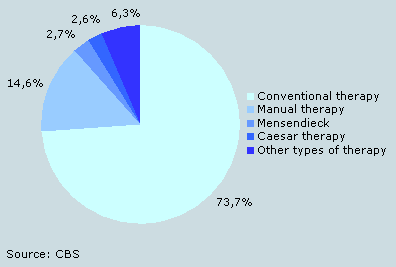Over one in six persons visited physiotherapist last year

In 2005, more than one in six people in the Netherlands contacted a physiotherapist, as against one in fourteen in the early 1980s.
Marginal increase due to ageing of the population
Ageing of the population accounts for approximately 10 percent of the increase in the number of persons receiving physiotherapeutic treatment in the past 25 years. The increase is mainly the result of improved treatment methods and accessibility of physiotherapeutic care, but is also due to more physiotherapists working in an extramural setting.
Fewer treatments per patient
The average annual number of treatments per patient has been reduced from 20 treatments in the late 1980s to 17 in 2006. Restrictive measures curbed the number of treatments per patient.
Contact with physiotherapist last year

Physiotherapy by type of therapy
According to the health care survey, physiotherapy also includes various other forms of therapy, such as manual therapy and remedial therapies (Cesar and Mensendieck). These types of therapy account for one quarter of total physiotherapeutic treatments.
In the period 1997-2005, the annual number of treatments per patient was 12 for manual therapy, 14 for Mensendieck and 15 for Cesar therapy.
Types of physiotherapeutic treatments, 1997-2005

More young patients receive Mensendieck and Cesar therapy
Regardless of the type of therapy, most patients are aged between 25 and 64. As many as four in five people in this age category receive manual therapy. One in five patients receiving treatment by a physiotherapist are over 65 years old. Proportionally, many young patients receive Mensendieck and Cesar remedial therapy. Two in five people receiving Cesar therapy are under 25.
Age distribution of patients by type of therapy, 1997-2005

Frans Frenken